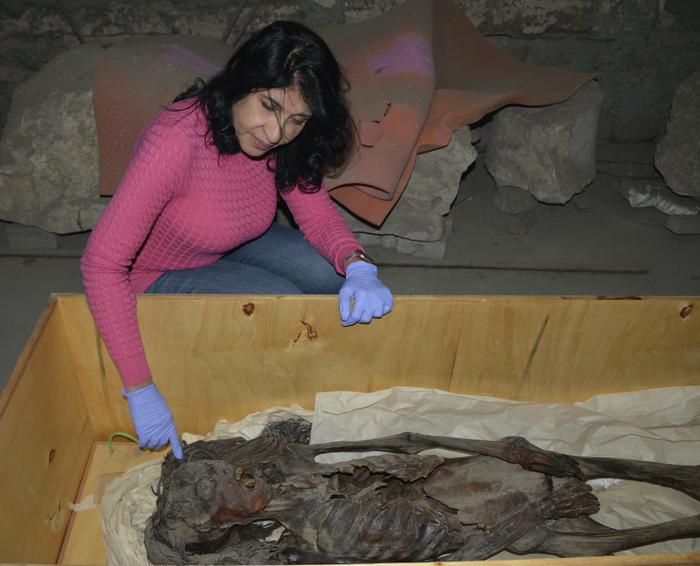Causes of Death for the ‘Screaming Woman’ Mummy Still Remain a Mystery
Posted on Categories Discover Magazine

In 1935, researchers discovered a mummy whose face was frozen in what appeared to be an eternal pain-filled rictus. Anthropologists have wondered for nearly a century why the mummy was buried with that frozen horrific expression.
According to a report in Frontiers in Medicine, experts have now ruled out some possible causes.
Investigating Screaming Mummies
Co-author Sahar Saleem, a professor of radiology at Kasr Al Ainy Hospital of Cairo University, became an accidental expert on screaming mummies. “Initially, I did not seek to study screaming mummies,” she says.
Throughout 20 years of investigating two royal mummies with widely opened mouths as if screaming: Prince Pentawer (1185-1153 B.C.) and Princess Meritamen (1533-1525 B.C.) — as well as examining the “Screaming Woman” with CT scans and other imaging techniques — Saleem ruled out two theories for the woman’s expression: poor embalming and a death by physical trauma.
Read More: The Eternal Mummy Princesses
The Secrets of Ancient Embalming Techniques
(Credit: Sahar Saleem)
It was unlikely that the Screaming Woman was intentionally embalmed poorly. The researchers found juniper resin and frankincense on the mummy’s surface.
“These embalming materials are expensive and imported,” says Saleem.
Also, her natural hair had been dyed with henna and juniper and she wore a wig treated with quartz, magnetite, and albite crystals. Those costly and time-consuming techniques go against the notion that the woman was intentionally mummified quickly and cheaply.
There was also no sign that the woman suffered any sudden trauma that would elicit a scream. They found no sign of a head injury, as in King Seqenere Taa II, or slit neck as in King Ramesses III (1185-1153 B.C.).
Read More: Ancient Mummy-Making Techniques Are Finally Unwrapped
Atypical Mummification
What was unusual in the Screaming Woman was the method of mummification. The CT scans showed no embalming incision and all organs remained intact.
“This was a surprise to me, as the classic method of mummification in the New Kingdom (1550–1069 B.C.) included the removal of all organs except the heart,” says Saleem.
Before that period, bodies were buried in the Egyptian desert, often with minimal preparation. This often indicated a low socioeconomic status. Such mummies are rarely found in good condition.
“Usually, such bodies are badly preserved,” says Saleem. “Unlike what we expected in a mummified body that lacked evisceration, the body of the Screaming Woman was well-preserved!”
Read More: Why are the World’s Oldest Mummies Deteriorating, and Who Made Them?
Why Mummification was Important
(Credit: Sahar Saleem)
Another mummy, called the Meritamen mummy, may be the closest known case of the Screaming Woman. That mummy, who was also buried with an open mouth, exhibited severe coronary atherosclerosis, and possibly died of a heart attack. Although the Screaming Woman didn’t show similar signs of heart disease, it’s likely that she suffered some severe physical or emotional shock before she died.
In some such cases, corpses undergo a cadaveric spasm, where one group of muscles becomes rigid immediately following death. This is essentially rigor mortis — but for only an isolated area.
Since the goal of ancient Egyptian mummification was to preserve the deceased body, ancient Egyptians likely embalmed the Screaming Mummy before it decomposed or the face relaxed. “It is possible that the contracted muscles must have prevented embalmers from closing the mouth,” says Saleem.
But because the researchers found no clear cause of death for the Screaming Woman, a definitive reason for her expression remains a mystery.
Read More: How Ancient Egyptians Preserved Bodies for the Afterlife
Article Sources
Our writers at Discovermagazine.com use peer-reviewed studies and high-quality sources for our articles, and our editors review for scientific accuracy and editorial standards. Review the sources used below for this article:
Before joining Discover Magazine, Paul Smaglik spent over 20 years as a science journalist, specializing in U.S. life science policy and global scientific career issues. He began his career in newspapers, but switched to scientific magazines. His work has appeared in publications including Science News, Science, Nature, and Scientific American.